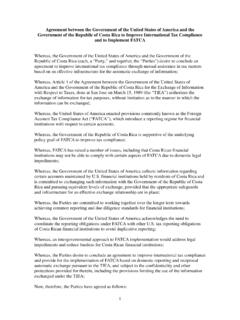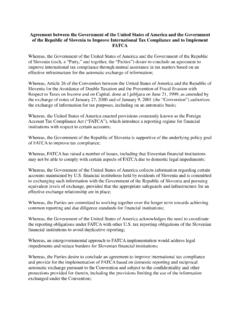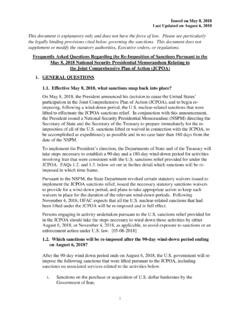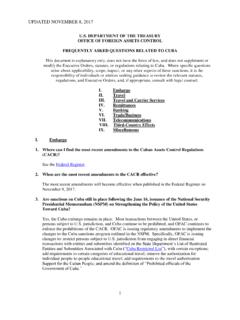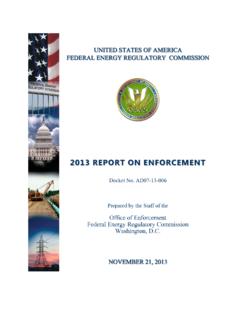Transcription of United States ‒ Progress Report on Fossil Fuel Subsidies
1 1 United States Progress Report on Fossil Fuel Subsidies Part 1: Identification and Analysis of Fossil Fuel Provisions A. Production Fossil Fuel Subsidies There are a number of tax preferences, described below, available in the United States to producers of Fossil fuels. The preferences below are all permanent provisions in the tax code. The annual revenue costs estimated for each provision are taken from the Mid-Session Review of the Budget of the United States Government, Fiscal Year 2015, which is available here: Provision descriptions are derived from the General Explanation of the Administration s Revenue Proposal, sometimes referred to as the Treasury Green Book, which is available here: In total, the United States government has identified eleven Federal Fossil fuel production tax provisions, as shown below.
2 Combined, these provisions total USD billion in annual revenue cost (nominal annual average figure based on the 10-year revenue estimate). The provisions are listed in order of greatest annual revenue cost to least. 2 Production Tax Provision Fossil Fuel Targeted Description Analysis Expiration Annual Revenue Cost (million)1 Expensing of intangible drilling costs Oil natural Gas Taxpayers may elect to currently deduct intangible drilling costs (IDCs) paid or incurred with respect to the development of an oil or natural gas property located in the United States .
3 For an integrated oil company that has elected to expense IDCs, 30 percent of the IDCs on productive wells must be capitalized and amortized over a 60-month period. The expensing, rather than capitalization, of IDCs provides a tax preference to the oil and natural gas industry. Requiring capitalization of IDCs would place the oil and natural gas industry on a cost recovery system similar to that employed by other industries and reduce economic distortions. This provision, like other oil and natural gas preferences the Administration proposes to repeal, distorts markets by encouraging more investment in the oil and natural gas industry than would occur under a neutral tax system.
4 This market distortion is detrimental to long-term energy security and is also inconsistent with the Administration s policy of supporting a clean energy economy, reducing our reliance on oil, and cutting carbon pollution. Moreover, the tax subsidy for oil and natural gas must ultimately be financed with taxes that result in underinvestment in other, potentially more productive, areas of the economy. None $1,495 3 Production Tax Provision Fossil Fuel Targeted Description Analysis Expiration Annual Revenue Cost (million)1 Percentage depletion for oil and natural gas wells Oil natural Gas Depletion is available to any person having an economic interest in a producing oil and natural gas property.
5 There are generally two types of depletion cost and percentage depletion. Cost depletion is limited to the taxpayer s basis in the property, whereas percentage depletion is not limited by the basis, but is subject to other limitations. Percentage depletion for producing oil and natural gas property (15 percent rate) is available only to independent producers and royalty owners and is limited to average production of 1,000 barrels of oil per day or its natural gas equivalent. The percentage depletion deduction is further generally limited to the lesser of 65 percent of the taxable income before the depletion allowance or 100 percent of the taxable income from the property before the depletion allowance.
6 Percentage depletion effectively provides a lower rate of tax with respect to a favored source of income relative to cost depletion. Cost depletion computed by reference to the taxpayer s basis in the property would place oil and natural gas producers on a cost recovery system similar to that employed by other industries and reduce economic distortions. See expensing of intangible drilling costs for further analysis of the effects of Fossil fuel tax preferences. None . $1,343 Domestic manufacturing deduction for Fossil fuels Oil natural Gas Coal Lignite Oil Shale A deduction is allowed with respect to income attributable to domestic manufacturing and production activities.
7 For taxable years beginning after 2009, the manufacturing deduction is generally equal to nine percent of the lesser of qualified production activities income for the taxable year or taxable income for the taxable year, limited to 50 percent of the W-2 wages of the taxpayer for the taxable year. The deduction for income from oil and natural gas production activities is computed at a six-percent rate. This deduction is widely available and not targeted at Fossil fuel industries. The manufacturing deduction, which is available to all taxpayers that generate qualified production activities income, effectively provides a lower rate of tax for income from certain activities, including the production of Fossil fuels.
8 See expensing of intangible drilling costs for further analysis of the effects of Fossil fuel tax preferences. None $1,250 4 Production Tax Provision Fossil Fuel Targeted Description Analysis Expiration Annual Revenue Cost (million)1 Two year amortization period for geological & geophysical expenditures Oil natural Gas Geological and geophysical expenditures incurred by independent producers in connection with domestic oil and natural gas exploration may be amortized over two years. For integrated oil companies, these costs must be amortized over seven years.
9 The accelerated amortization of geological and geophysical expenditures incurred by independent producers provides a tax preference to the oil and natural gas industry. Increasing the amortization period for geological and geophysical expenditures incurred by independent oil and natural gas producers from two years to seven years would provide a more accurate reflection of their income and more consistent tax treatment for all oil and natural gas producers. See expensing of intangible drilling costs for further analysis of the effects of Fossil fuel tax preferences.
10 None $305 Percentage depletion for hard mineral Fossil fuels Coal Lignite Oil Shale Percentage depletion is available for coal and lignite (10 percent rate) and oil shale (15 percent rate). The percentage depletion deduction is generally subject to the alternative minimum tax at a 20 percent rate to the extent it exceeds the adjusted basis of the property. The deduction may not exceed 50 percent of the net income from the mineral property in any year. Percentage depletion, rather than cost depletion, effectively provides a lower rate of tax with respect to a favored source of income.



